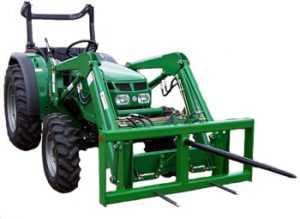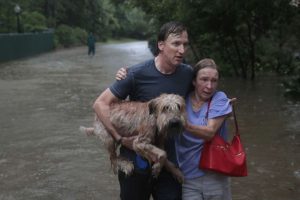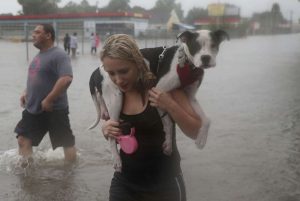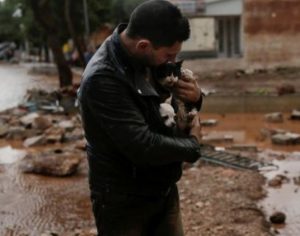 Sometimes stuff just happens. Before my father passed away, my parents had a cattle farm in central Texas with over 100 registered cows. They decided to take a much-needed vacation to see Alaska, one of the big items on their bucket list. They arranged for a neighbor to watch over the animals for the 15 day trip and took off. Eight days later, while my parent’s ship was in the middle of the ocean, tornadoes and unseasonable heavy rainfall swept through their county, causing severe flooding of the Nolan River, which ran through their property. The cows, which everyone knows are super-intelligent creatures, were hanging out in the bottom land and were caught in the flash floods. Most of them were swept downriver and drowned, their bodies strewn over several miles. Texas law regarding dead animals in waterways makes no provision for Alaskan cruises and requires the owner to remove dead carcasses within 72 hours to avoid contamination of the waterway and spread of disease. Owners failing to do so are fined and charged heavily for the County to remove and dispose of the dead livestock. I caught the first plane to Texas and spend the next 3 days atop a tractor mounted with a hay spike. A hay spike is an 8’ sharpened pole used to skewer and move large round bales of hay. It works pretty good on dead cows too, but what a mess…
Sometimes stuff just happens. Before my father passed away, my parents had a cattle farm in central Texas with over 100 registered cows. They decided to take a much-needed vacation to see Alaska, one of the big items on their bucket list. They arranged for a neighbor to watch over the animals for the 15 day trip and took off. Eight days later, while my parent’s ship was in the middle of the ocean, tornadoes and unseasonable heavy rainfall swept through their county, causing severe flooding of the Nolan River, which ran through their property. The cows, which everyone knows are super-intelligent creatures, were hanging out in the bottom land and were caught in the flash floods. Most of them were swept downriver and drowned, their bodies strewn over several miles. Texas law regarding dead animals in waterways makes no provision for Alaskan cruises and requires the owner to remove dead carcasses within 72 hours to avoid contamination of the waterway and spread of disease. Owners failing to do so are fined and charged heavily for the County to remove and dispose of the dead livestock. I caught the first plane to Texas and spend the next 3 days atop a tractor mounted with a hay spike. A hay spike is an 8’ sharpened pole used to skewer and move large round bales of hay. It works pretty good on dead cows too, but what a mess…
 Fortunately, most of us only have to deal with a dog or a cat, not hundreds of large animals. Yet, following every major disaster you see sad stories about all the recovered pets. People just failed to plan ahead or anticipate how badly they’ll be affected by the storm. Nowadays I’ve limited my herd to two cats. Both are timid and freak out at any noise, especially lightning and thunder. I can only imagine their reaction to a tree crashing onto my roof or the wind blowing something through a picture window. They’d mindlessly flee through the opening and not stop running until they hit the next county. That’s probably how many of the animals in TX, LA, FL and PR became homeless.
Fortunately, most of us only have to deal with a dog or a cat, not hundreds of large animals. Yet, following every major disaster you see sad stories about all the recovered pets. People just failed to plan ahead or anticipate how badly they’ll be affected by the storm. Nowadays I’ve limited my herd to two cats. Both are timid and freak out at any noise, especially lightning and thunder. I can only imagine their reaction to a tree crashing onto my roof or the wind blowing something through a picture window. They’d mindlessly flee through the opening and not stop running until they hit the next county. That’s probably how many of the animals in TX, LA, FL and PR became homeless.
 Pet Carriers. For predictable events, you can avoid losing your pet by putting them into their carrier or cage. If you have to evacuate moving a panicked animal in a carrier is much safer for you than carrying them in your arms. I can’t imagine how hard it would be to carry two scared, squirming cats through a driving rain while each independently try to bite or claw their way out of my arms. I’d probably bleed to death before getting them into my car.
Pet Carriers. For predictable events, you can avoid losing your pet by putting them into their carrier or cage. If you have to evacuate moving a panicked animal in a carrier is much safer for you than carrying them in your arms. I can’t imagine how hard it would be to carry two scared, squirming cats through a driving rain while each independently try to bite or claw their way out of my arms. I’d probably bleed to death before getting them into my car.
Chipping your pets. If you have outdoor pets, bring them inside temporarily so they won’t be frightened into running away during the height of the storm, never to be seen again. Consider chipping all of your pets, even the indoor ones. In every disaster the rescue agencies have chip readers and can quickly identify the pet and reunite them with their owner.
Food. Pet food is another dimension few consider. My cats are finicky eaters, so when I run out of fancy feast they get very…vocal. That’s why I have “buy cat food” on my ‘Do this if you have time” checklist sitting atop my ”go bag”. I try to keep 30 days’ worth of their favorite canned food on the shelf, but as insurance I also keep 25 pounds of cheap ($9) hard food in a sealed 5-gallon bucket. I figure that in an emergency where they get hungry enough, they’ll be happy to have it. Every six months I buy a new bag and feed the old one to my neighbor’s dumb dogs.
 Leashes/harnesses. Try to locate collars, leashes and harnesses and keep them with your “go bag”. If you’re forced to evacuate unexpectedly, it’ll be a lot easier with a leashed animal instead of carrying it in your arms.
Leashes/harnesses. Try to locate collars, leashes and harnesses and keep them with your “go bag”. If you’re forced to evacuate unexpectedly, it’ll be a lot easier with a leashed animal instead of carrying it in your arms.
Vaccination records. If you must evacuate to a shelter make SURE you have your pet’s vaccination records. In past disasters shelters wouldn’t allow animals to enter unless they had proof of vaccinations. In some cases they offered vaccinations but avoid the trouble and expense by keeping copies in a sealed Ziploc bag in your “go bag”.
Pet Prescriptions. Like human pharmacies, few veterinarian offices will be open after a major event. If your pet needs medications, you’ll need to put them into your “go bag” alongside your own medications.